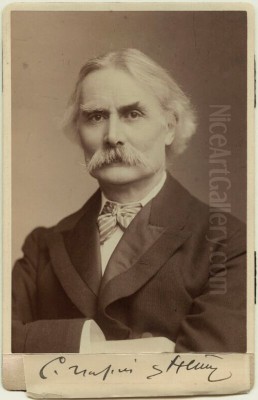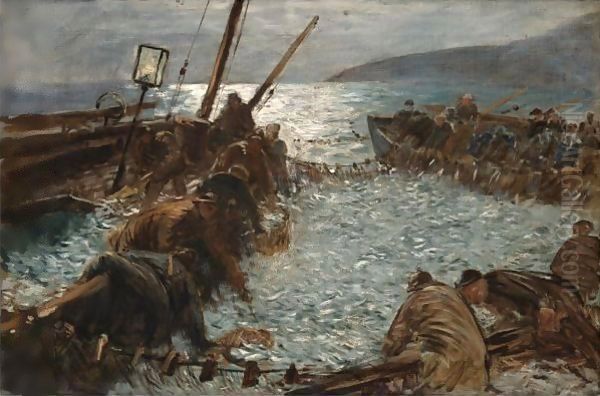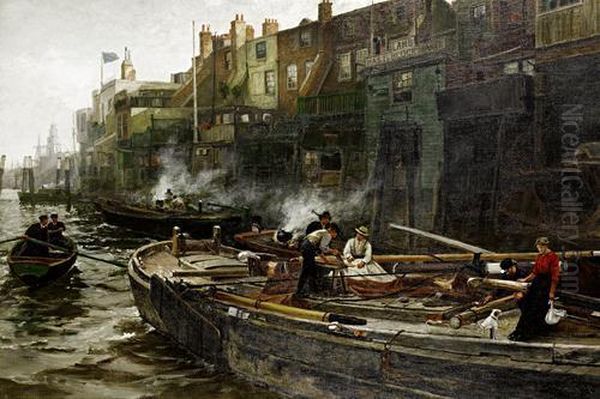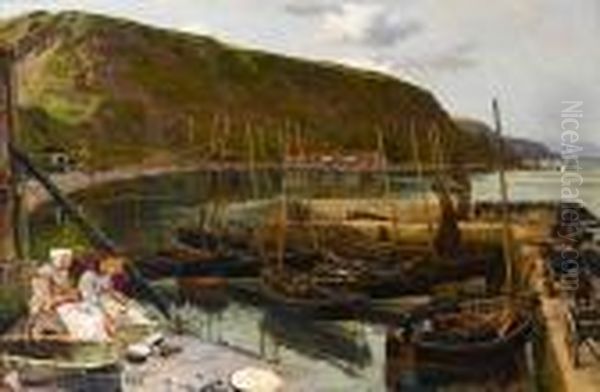
Charles Napier Hemy stands as a significant figure in British art history, particularly renowned for his powerful and evocative depictions of the sea, coastal life, and maritime activity. Active during the late Victorian and Edwardian periods, Hemy carved a unique niche for himself, combining meticulous observation with a profound understanding of the ocean's moods and the lives of those who depended upon it. His work captures the dynamism, beauty, and often the harsh reality of Britain's relationship with the sea, earning him considerable acclaim during his lifetime and a lasting place in the annals of marine painting.
Early Life and Formative Experiences
Charles Napier Hemy was born in Newcastle upon Tyne on May 24, 1841. His upbringing was steeped in creativity, though initially more musical than visual. His father, Henri Christophe Hemy, was a musician and composer of some note. Charles was the eldest son, and artistic inclinations ran in the family; his younger brothers, Thomas Marie Madawaska Hemy and Bernard Benedict Hemy, would also pursue careers as painters, specializing, like Charles, in marine subjects, although they never achieved the same level of fame or critical success as their elder brother.
A pivotal experience occurred in Hemy's youth. When he was around ten years old, in 1850 or 1851, the family emigrated to Australia. This long sea voyage across vast oceans undoubtedly left an indelible mark on the young boy. Witnessing the sea's immense power, its changing colours, and the isolation of being surrounded by water provided firsthand experience that would later inform his art. This early exposure gave him a deep-seated respect for the ocean's dangers and majesty, themes that resonate throughout his mature work.

The family did not remain in Australia permanently, returning to England after a few years. Hemy's path towards art was not immediate or straightforward. He initially felt a strong religious calling and spent time in a Dominican monastery in Newcastle and later studied for the priesthood in Lyon, France. However, the pull towards art proved stronger. He also reportedly spent some time living on St. Lawrence Island in Newfoundland, further immersing himself in coastal environments and the lives of seafaring communities, gathering invaluable material for his future artistic endeavours.
Artistic Training and Early Influences
Hemy's formal art education began at the Newcastle School of Art. Here, he studied under William Bell Scott, a painter and poet associated with the Pre-Raphaelite Brotherhood, although not a core member himself. Scott's teaching likely introduced Hemy to the Pre-Raphaelite emphasis on detailed observation, truth to nature, and bright, clear colour palettes. This influence is discernible in Hemy's earlier works, which often display a high degree of finish and meticulous attention to detail.
Seeking further refinement, Hemy travelled to Antwerp, a major European art centre. From around 1867, he studied at the Antwerp Academy and, significantly, worked in the studio of the renowned Belgian historical painter Baron Hendrik Leys. Leys was known for his large-scale historical and genre scenes, executed with a revivalist approach inspired by 16th-century German and Flemish masters. While Hemy would ultimately focus on marine subjects rather than historical narratives, his time with Leys would have reinforced the importance of strong draughtsmanship, careful composition, and a disciplined approach to painting.
During the 1860s and early 1870s, Hemy exhibited works that reflected these influences, including religious and historical subjects alongside his developing interest in coastal scenes. He spent time working in London and back in Newcastle, gradually establishing his reputation. His early style, while detailed, began to show the foundations of his later focus on maritime life.
The Move to Falmouth and Artistic Maturity
A decisive moment in Hemy's career came in 1881 when he moved with his family to Falmouth, Cornwall. This relocation proved immensely fruitful. Cornwall, with its dramatic coastline, clear light, and vibrant fishing communities, was becoming a magnet for artists. While often associated with the nearby Newlyn School painters like Stanhope Forbes and Walter Langley, who focused on figurative scenes of fishing life with a distinct social realist bent, Hemy maintained a degree of independence in Falmouth.

His focus remained resolutely on the sea itself and the vessels that navigated it. Falmouth's busy harbour, Carrick Roads, provided endless subject matter. Crucially, Hemy acquired a large yacht, the 'Vandevelde', which he converted into a floating studio. This allowed him to work directly from nature, observing the sea in all its conditions from a unique vantage point. He would anchor offshore, studying the complex patterns of waves, the effects of light on water, and the intricate details of boats and rigging at close quarters.
This practice of working en plein air (outdoors), or rather en plein mer (at open sea), was fundamental to the authenticity and dynamism of his work. It enabled him to capture the immediacy and energy of the marine environment in a way that studio-bound work could not replicate. He became an expert observer of wave morphology, understanding how wind and tide shaped the water's surface. This floating studio became legendary, a testament to his dedication to capturing the sea's true character.
Style and Technique: Realism and Dynamism
Hemy's mature style is characterized by a robust realism, combined with a powerful sense of movement and atmosphere. While the meticulous detail of his early Pre-Raphaelite influenced phase evolved into a broader, more fluid handling of paint, his commitment to accurate observation remained paramount. He possessed an exceptional ability to render the weight and volume of water, the play of light across its surface, and the force of wind and waves.
His compositions often feature a high horizon line, emphasizing the vast expanse of the sea and immersing the viewer in the scene. Boats, whether fishing vessels, pilot cutters, or larger ships, are depicted with accuracy and a sense of solidity, battling the elements or navigating calmer waters. He was particularly adept at capturing the specific textures and colours of the sea – the deep blues and greens of open water, the translucent quality of breaking waves, the foam and spray kicked up by wind or a boat's passage.
Unlike the Impressionists, who were exploring fragmented light and colour contemporaneously, Hemy's realism was more solid and tangible. Yet, his work is far from photographic. He infused his scenes with atmosphere and drama, conveying the mood of the sea – be it the tranquility of a calm harbour mooring or the tension of a vessel battling a storm. His brushwork, while descriptive, often has a vigour that contributes to the overall sense of energy. He worked primarily in oils and watercolour, achieving mastery in both media.
Major Works and Recognition

Throughout his career, Hemy produced a substantial body of work, exhibiting regularly at the Royal Academy in London and other major institutions. Several paintings stand out as particularly representative of his achievement.
Pilchards (1897): Arguably his most famous painting, Pilchards is now housed in the Tate collection. Purchased for the nation under the Chantrey Bequest, it depicts a bustling scene of Cornish fishermen hauling in nets laden with pilchards, their boat pitching in the choppy sea. The painting is celebrated for its dynamic composition, its realistic portrayal of the fishermen's labour, and its masterful rendering of the turbulent water and silvery fish. It exemplifies Hemy's ability to combine human activity with the powerful presence of the sea.
London River (1904): Also in the Tate collection and acquired through the Chantrey Bequest, this work shows a different aspect of maritime life – the busy traffic of the Thames near Limehouse. Tugboats, barges, and steamers navigate the murky waters under a smoky, industrial sky. It captures the atmosphere of the working river and showcases Hemy's versatility in depicting different types of vessels and water conditions. An earlier, related work, The Riverside, Limehouse (c. 1875), demonstrates his long-standing interest in the Thames and achieved a high price at auction, indicating the market value of his major pieces.
The Oyster Dredger (1878): Housed in the Williamson Art Gallery & Museum, Birkenhead, this earlier work depicts the traditional practice of oyster dredging, likely observed during his time near the coast. It shows his developing interest in documenting maritime labour and coastal communities, rendered with the detailed approach characteristic of his earlier style.
Hauling the Trammel Net (or The Trammel of the Net) (1892): Exhibited at the Royal Academy, this painting, like Pilchards, focuses on the activity of fishing. It captures the physical effort involved and the relationship between the fishermen and their environment, showcasing his skill in depicting figures within a dynamic seascape.
Making The Run For Home, Cornish Coast (1915): A later work, this painting depicts a sailing vessel navigating towards the coast, likely Falmouth, under sail. It demonstrates his continued mastery of depicting sailing ships and the coastal environment late in his career.

Home Mooring (1894-95): Exhibited at the Royal Academy, this work likely depicted a vessel safely returned to harbour, showcasing his ability to capture quieter, more atmospheric moments alongside the dramatic scenes of open water.
Hemy's consistent quality and dedication earned him significant recognition. He was elected an Associate of the Royal Academy (ARA) in 1898 and a full Royal Academician (RA) in 1910. He was also a member of the Royal Institute of Painters in Water Colours. His success was not just critical but also commercial; his paintings were popular with collectors who appreciated their accuracy, drama, and distinctly British subject matter. There is also mention of him acting as an official painter for the Royal Yacht Squadron, reflecting his high standing in maritime art circles.
Contemporaries, Connections, and Influence
Charles Napier Hemy worked during a vibrant period in British art. While associated with the Pre-Raphaelite tradition through his teacher William Bell Scott and his early style's affinity with the detailed naturalism of artists like John Everett Millais or William Holman Hunt, his primary focus set him apart. His dedication to marine subjects places him in a lineage that includes the great J.M.W. Turner, though Hemy's approach was generally more literal and less focused on sublime abstraction than Turner's later work.
In Cornwall, he was a contemporary of the Newlyn School artists like Stanhope Forbes, Walter Langley, and Frank Bramley. While sharing an interest in coastal life and realist depiction, the Newlyn painters typically focused more on figurative genre scenes set within the fishing community, often with a stronger social commentary element, whereas Hemy's primary subject remained the sea and the vessels upon it.
He had connections with other artists, including the versatile Frank Brangwyn, himself a powerful painter who depicted maritime labour and seascapes, albeit often with a bolder, more decorative style than Hemy's. Brangwyn was noted as an expert on wave forms, suggesting shared interests and potential interactions between the two artists. Hemy's own brothers, Thomas and Bernard, continued the family tradition of marine painting.
Hemy's influence extended to the next generation of marine artists. Most notably, Montague Dawson, who became one of the most successful and prolific marine painters of the 20th century, was significantly influenced by Hemy. Dawson admired Hemy's work, and similarities in their handling of the sea, particularly the depiction of waves and the dramatic rendering of sailing ships, are evident. Dawson essentially carried Hemy's brand of dramatic maritime realism forward into the mid-20th century. Other later marine artists, like Norman Wilkinson, also worked within a broadly realist tradition, though developing their own distinct styles. Compared to American contemporaries like Winslow Homer, whose marine works often convey a raw, elemental power, Hemy's paintings, while dramatic, generally retain a strong sense of Victorian narrative and detailed observation.
Personal Life and Views
Beyond his art, Hemy maintained a strong connection to his Catholic faith throughout his life, a remnant perhaps of his early consideration of the priesthood. This deep-seated religious belief coexisted with his dedication to his art. He was known to be a robust, somewhat bluff personality, fitting for someone who spent so much time confronting the elements at sea.
However, some recorded anecdotes reveal less appealing aspects of his character, reflecting common prejudices of his time. He reportedly held conservative views regarding the capabilities of women, expressing skepticism about their potential for high achievement in fields like art and music. While perhaps not uncommon for a man of his era and background, this stands in contrast to the growing movement for female emancipation and the increasing number of successful female artists emerging during his lifetime.
He remained based in Falmouth for the rest of his life, working diligently from his home, 'Churchfield', and his floating studio. He died in Falmouth on September 30, 1917, at the age of 76, leaving behind a significant legacy.
Legacy and Conclusion
Charles Napier Hemy occupies a vital place in the history of British marine art. He brought a unique combination of direct observation, technical skill, and dramatic sensibility to his subject. His decision to use a floating studio was innovative and allowed him an unparalleled intimacy with the sea, resulting in works of great authenticity and power. He captured the essence of Britain's maritime life during a period when the nation's identity was still deeply intertwined with the sea, from its naval power to its fishing industries.
His paintings, particularly works like Pilchards and London River, serve not only as outstanding examples of marine art but also as valuable historical documents, recording the vessels, activities, and atmosphere of a bygone era. His influence on subsequent marine painters, notably Montague Dawson, ensured that his approach to depicting the sea continued to resonate well into the 20th century.
While perhaps overshadowed in broader art historical narratives by movements like Impressionism or Post-Impressionism, Hemy remains a master within his chosen genre. His dedication to realism, his profound understanding of his subject, and his ability to convey the dynamic energy and atmospheric beauty of the sea secure his reputation as one of the most important and accomplished British marine painters of the late 19th and early 20th centuries. His works continue to be admired in public collections, including the Tate Britain, and sought after by collectors, a testament to their enduring appeal and artistic merit.